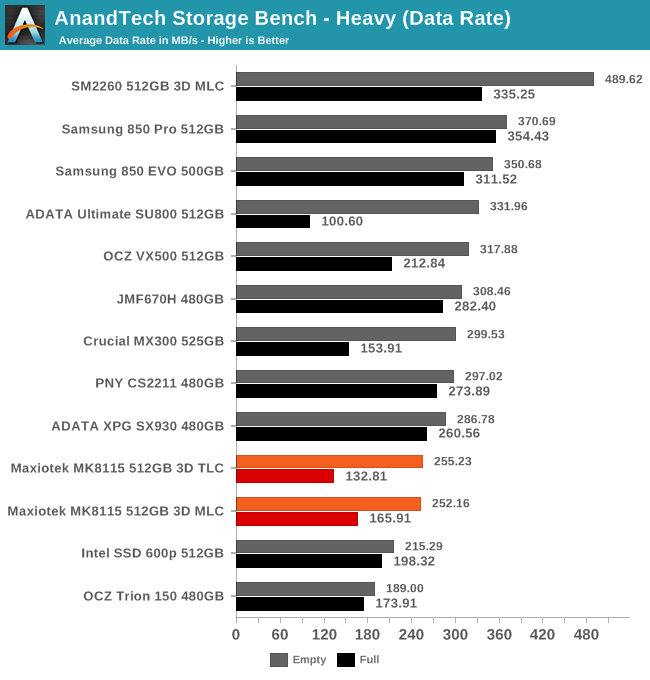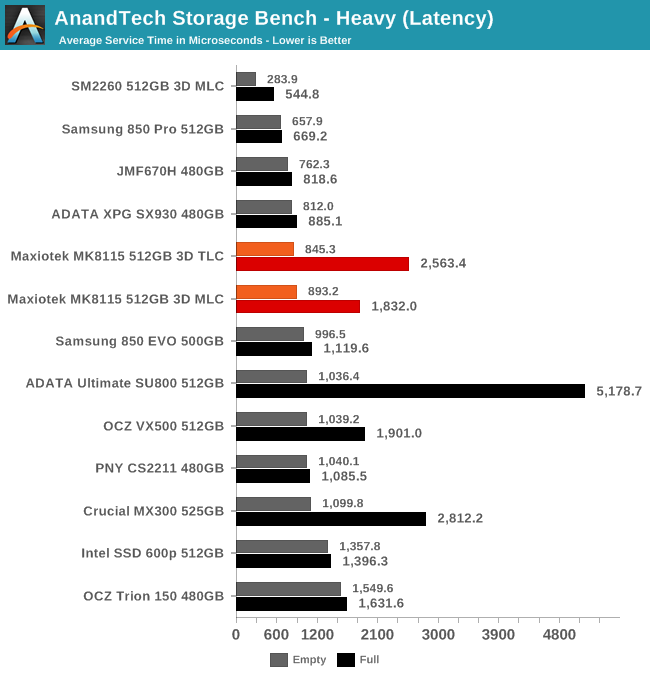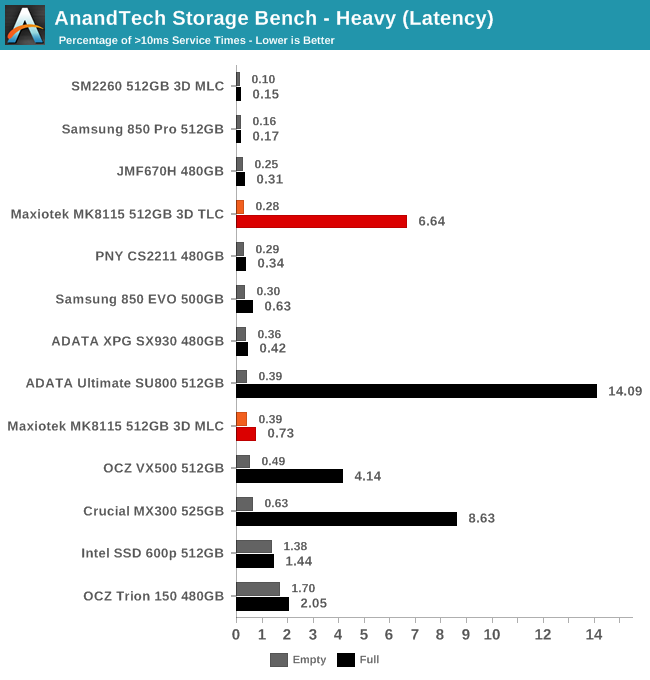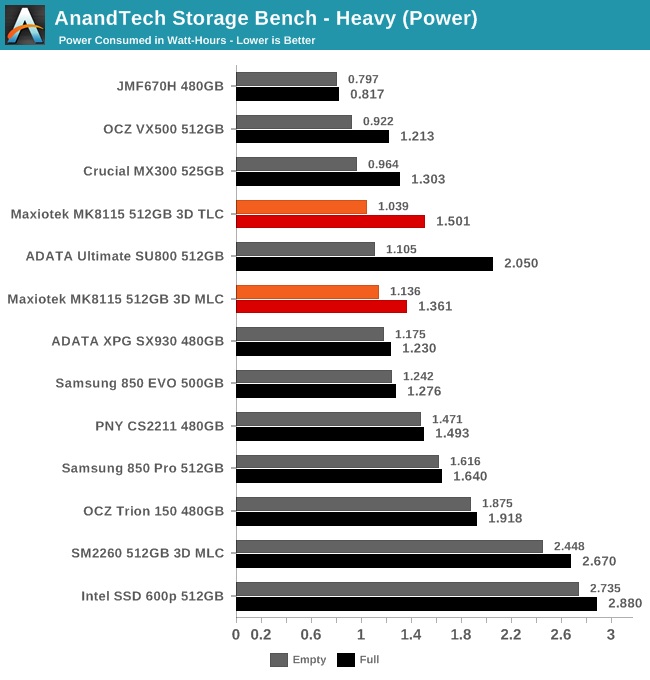Previewing Maxiotek's MK8115 SSD Controller: Can DRAM-less Drives Make The Cut?
by Billy Tallis on May 9, 2017 8:00 AM ESTAnandTech Storage Bench - Heavy
Our Heavy storage benchmark is proportionally more write-heavy than The Destroyer, but much shorter overall. The total writes in the Heavy test aren't enough to fill the drive, so performance never drops down to steady state. This test is far more representative of a power user's day to day usage, and is heavily influenced by the drive's peak performance. The Heavy workload test details can be found here.

The average data rates of the two MK8115 drives on the Heavy test are almost exactly the same when the test is run on an empty drive. Unfortunately that puts both of them quite near the bottom of the charts, behind the older JMicron drives and the other SATA SSDs using Micron 3D NAND.
When the test is run on a full drive, the MK8115 drives' performance suffers greatly, which has also been true of the other two SATA SSDs with Micron 3D NAND that we've tested. Most other SSDs show a far smaller degradation in performance from a full drive.

As on The Destroyer, average service times from the MK8115 drives aren't bad at all, if the test is run on an empty SSD. When the drive starts out full, average service time more than doubles, putting the MLC drive only slightly ahead of the OCZ VX500 and the TLC drive a little ahead of the Crucial MX300.

Both MK8115 drives have good control over high latency outliers when the Heavy test is run on an empty drive. The TLC sample surprisingly scores a bit better than the MLC sample. However, when the test is run on a full drive, the MLC sample's performance degradation is moderate while the TLC drive falls apart, though not quite to the extent of the Crucial MX300 or ADATA SU800.

The energy usage scores of the MK8115 drives on the Heavy test are good. The Crucial MX300 is still a bit better overall, but the Micron 3D NAND drives in general are all fairly efficient. They also all suffer noticeably when the test is run on a full drive, but it's not enough to make them worse than the slowest planar TLC SSDs or the fastest MLC SSDs that prioritize performance over power efficiency.










60 Comments
View All Comments
CheapSushi - Wednesday, May 10, 2017 - link
So you sold someone something without researching the hardware in it yourself? Kinda shady but likely he still enjoyed it.rocky12345 - Wednesday, May 10, 2017 - link
Shady? It was a pre built with 3 year warranty the finer detailed spec's were not revealed as in brands like SSD or system memory. He also wanted a gaming system but did not want to pay a lot of money. I would normally build the system myself as a custom so you know what every part is inside and you get to choose the build quality but since he wanted a gaming system on the cheap he got a pre built system. He is happy with it and it actually is a nice system for the money and he got a 3 year warranty from the OEM. So nothing shady going on here...lolwatzupken - Tuesday, May 9, 2017 - link
I am not sure if the price of such DRAM less SSDs is worth buying over a normal budget SSD. In every instance, it is performing very poorly against a budget SSD with DRAM.Lolimaster - Sunday, May 14, 2017 - link
If you're not an OEM than will sells tons of system to uninformed customers, get a good TLC or MLC if possible.jabber - Tuesday, May 9, 2017 - link
Bring back the good old BX100!nervegrind3r - Tuesday, May 9, 2017 - link
inZGamer - Saturday, May 13, 2017 - link
As much as people complain about the low performance....when benchmarking the drive, why compare it against high end consumer SSD's? Compare it against HHD's and SSHDs's where it would actually make sense. This style of drive is not intended to compete against an EVO 850, maybe an MX300 but that would even be pushing it. It will be interesting to see where this is kind of budget SSD ends up on the $/GB scale when it actual reaches production.Lolimaster - Sunday, May 14, 2017 - link
People are actually getting scammed with the prebuild OEM systems with SSD because THAT's when they will include shi*tty dram-less SSD's (in bulk $5-10 off of each system to sell them at the same price is a lot for OEM's).Similar to TLC SSD's, dram-less SSD's consistency goes to sh*t when you empty the SLC cache, if you don't implement it, even worse, you basically get writes slower than a 5400rpm HDD with the system pegging.
I would only touch 850 EVO's, Crucial MX300 for TLC, Kingston HyperX Savage or 850 pro for MLC.
genzai - Tuesday, May 16, 2017 - link
Seems like one good use for Optane would be to replace the DRAM (over a DDR interface) on drives like these.